JPY – Japanese Yen
Monetary System
1 ryō = 4 bu = 16 shu (until 1871)
1 Japanese yen (JPY) = 100 sen = 1,000 rin = 10,000 mon
Japanese Government
日本政府
The Japanese Government (GOV), also known as the Greater Japan Imperial Government during the days of the Japanese Empire, issued the first national banknotes in Japan following the fall of the Tokugawa Shogunate in late 1867 and the “restoration” of the emperor in early 1868. The Japanese Government continued to issue notes until 1948, albeit more and more sporadically and contemporaneously with other issuers. It also issued military notes and notes for use in occupied territories during World War II.
2024 Issues
On 9 April 2019, Japan’s Ministry of Finance announced plans to introduce a new series of notes in the first half of 2024. The new series will consists of three denominations (the existing 2,000-yen note is not being replaced) featuring bacteriologist Kitasato Shibasaburo on the 1,000-yen note; Tsuda Umeko, founder of Tsuda Juku University and the first Japanese woman to study in the US, on the 5,000-yen note; and industrialist Shibusawa Eiichi (who appears on Korea B201 – B206), on the 10,000-yen note. All three notes feature 3D holographic elements, elaborate watermarks, and larger denomination numbers to aid the sight-impaired. Existing notes will continue to circulate in parallel for three to four years. According to an article in the New York Times dated 15 April 2024, farmers in eastern Nepal cultivate argeli, an evergreen, yellow-flowering shrub found wild in the Himalayas, used primarily for firewood or fencing. But argeli bark, instead of the traditional mitsumata, is now being used by Kanpo Incorporated of Osaka to produce security paper for Japan’s new family of banknotes.
Description: 1,000.00 JPY – Japanese Yen Size: 150 x 76 mm
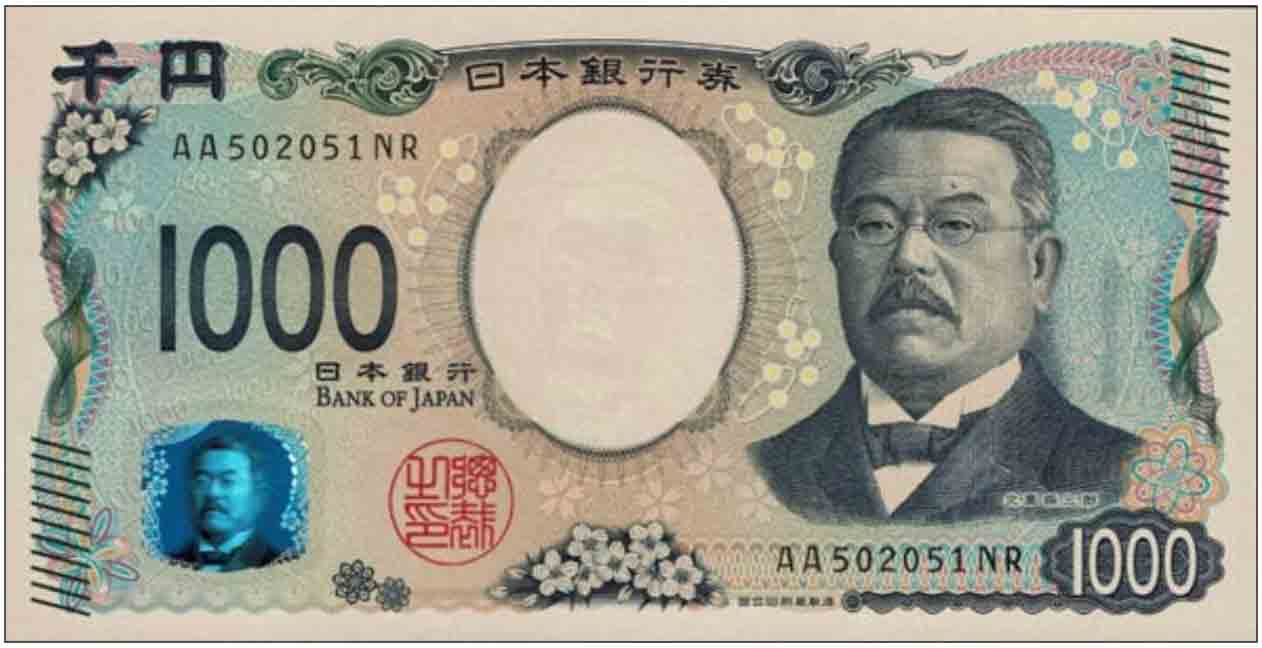
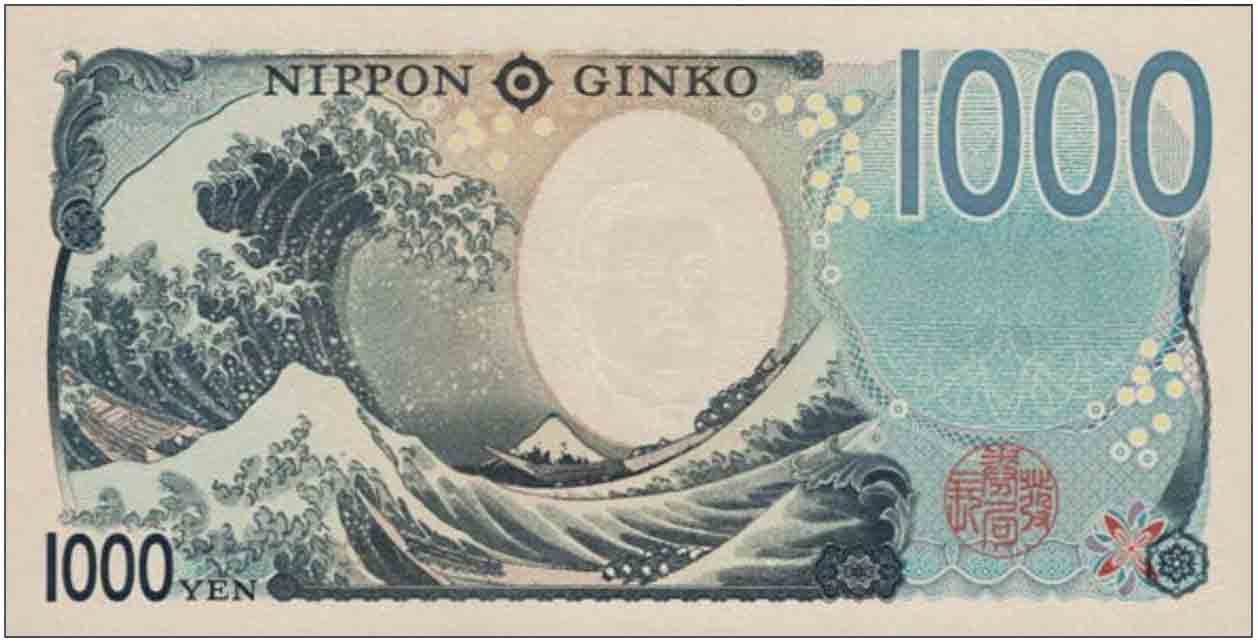
Blue, orange, and black. Front: Japanese text; flowers; Kitasato ShibasaburO (bacteriologist). Back: English text; Hokusai Katsushika’s woodblock print, “The Great Wave of Kanagawa” from “Thirty Six Views of Mount Fuji.” Holographic patch. No security thread. Watermark: Kitasato ShibasaburO and one vertical bars. Printer: aINAFP)611H (National Printing Bureau). 150 x 76 mm. Paper.
Description: 5,000.00 JPY – Japanese Yen Size: 156 x 76 mm

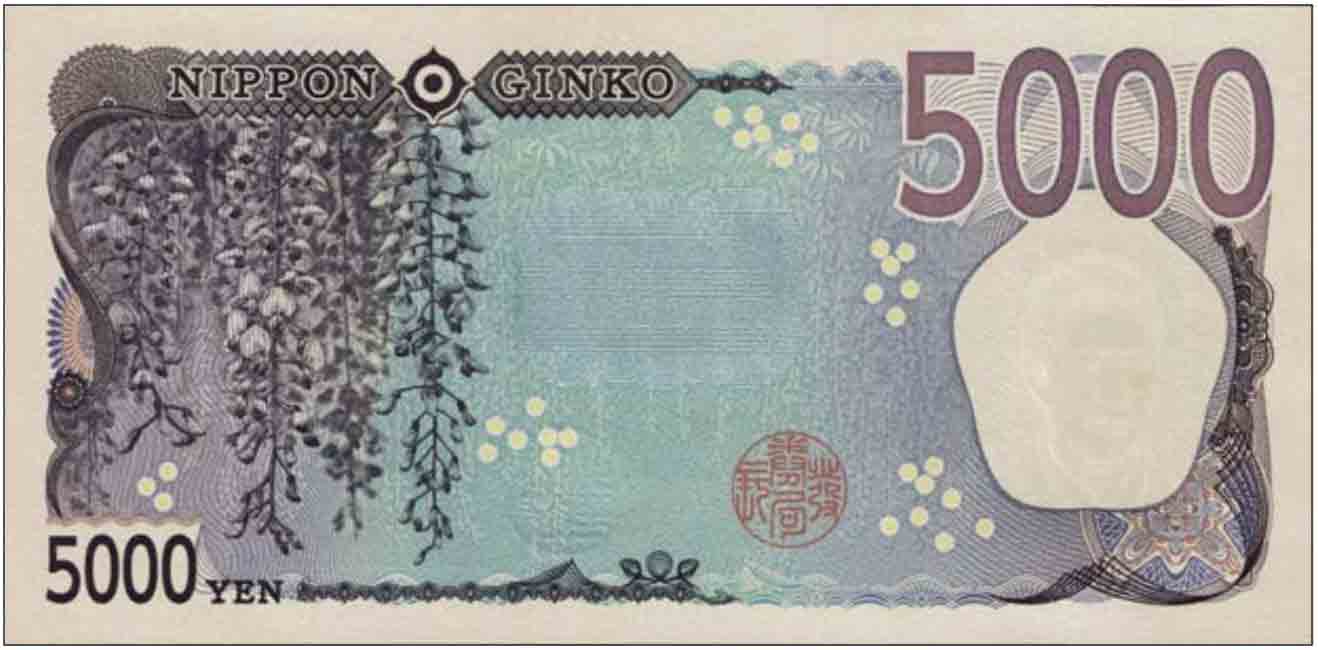
Lilac, blue, and black. Front: Japanese text; flowers; Tsuda Umeko (educator). Back: English text; wisteria flowers. Holographic stripe. No security thread. Watermark: Tsuda Umeko and two vertical bars. Printer: H )1/ E-PB’JR (National Printing Bureau). 156 x 76 mm. Paper.
Description: 10,000.00 JPY – Japanese Yen Size: 160 x 76 mm
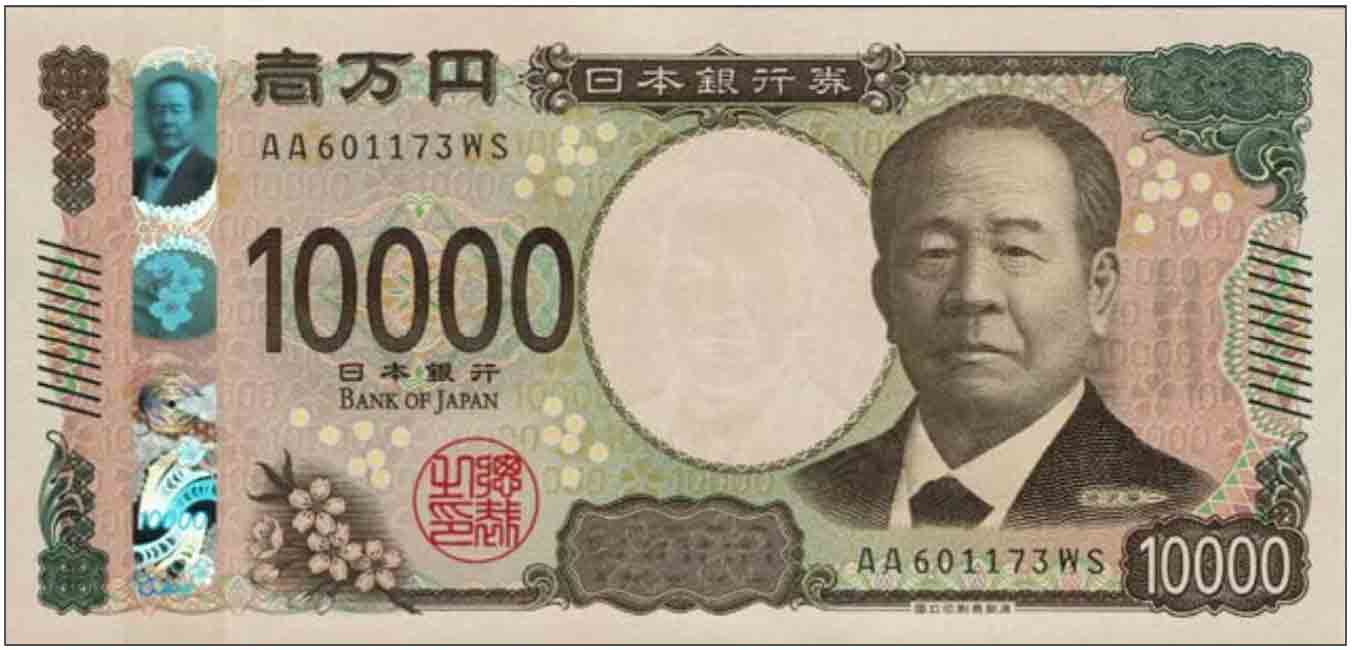
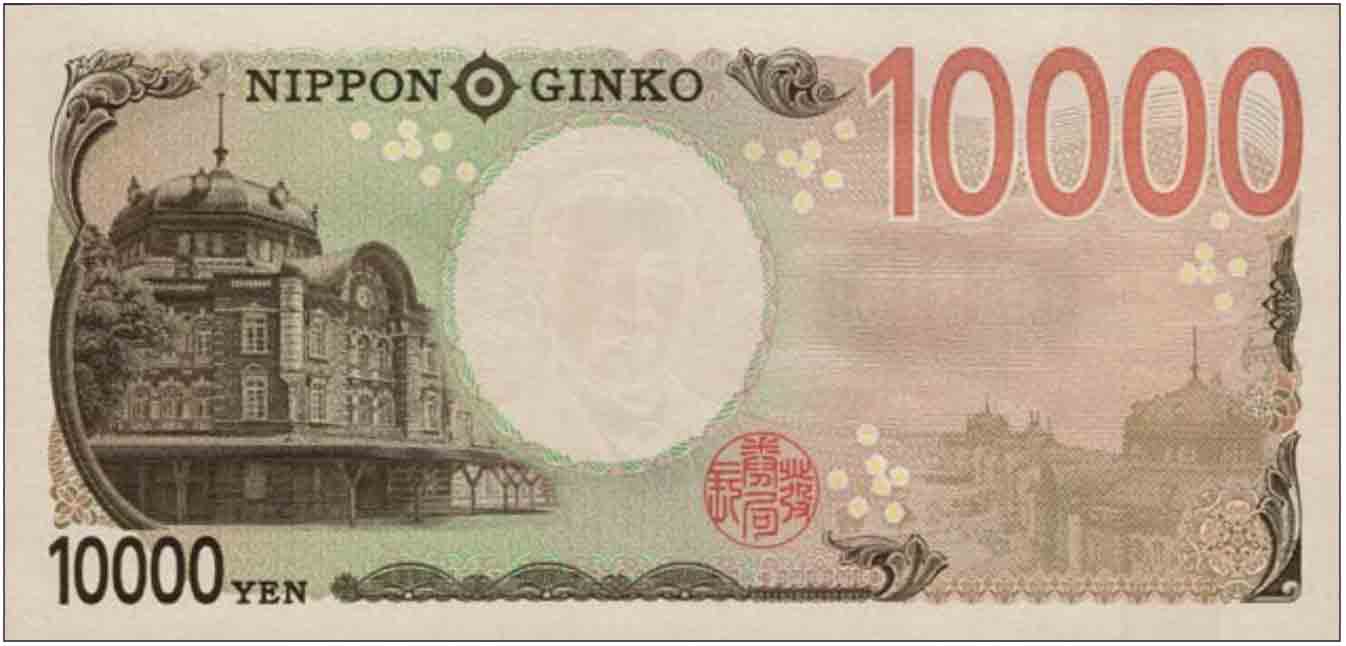
Brown, green, and black. Front: Japanese text; flowers; Shibusawa Eiichi (industrialist). Back: English text; Marunouchi side of red brick railroad Tokyo Station from 1914. Holographic stripe. No security thread. Watermark: Shibusawa Eiichi and three vertical bars. Printer: alPLFrigliR (National Printing Bureau). 160 x 76 mm. Paper.
2004 – 2019 Issues
These notes have the text 日本銀行券 (Bank of Japan note) at upper front and Nippon Ginko at upper back. Notes with 1-letter prefixes command a 1.5x premium.
Description: 1,000.00 JPY – Japanese Yen Size: 150 x 76 mm
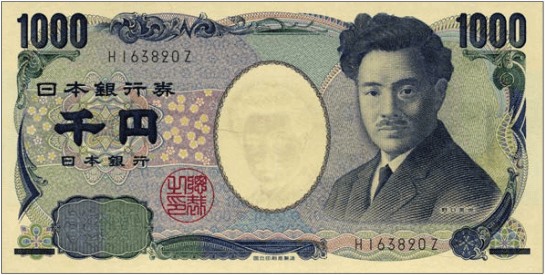
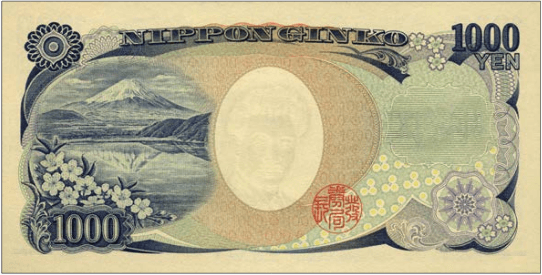
Blue. Front: Japanese text; Noguchi Hideyo (bacteriologist). Back: English text; Mount Fuji and foothills; plum blossoms. No security thread. Watermark: Noguchi Hideyo. Printer code: L. 150 x 76 mm. Paper.
Description: 5,000.00 JPY – Japanese Yen Size: 156 x 76 mm
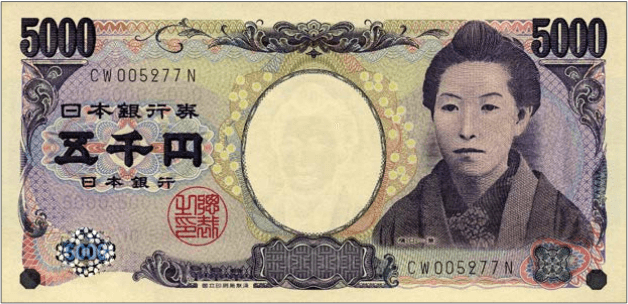

Lilac, yellow and orange. Front: Japanese text; Higuchi Ichiyō (author). Back: English text; Irises Screen by Ogata Kōrin (17th century artist). No security thread. Watermark: Higuchi Ichiyō. Printer code: L. 156 x 76 mm. Paper.
Description: 10,000.00 JPY – Japanese Yen Size: 160 x 76 mm

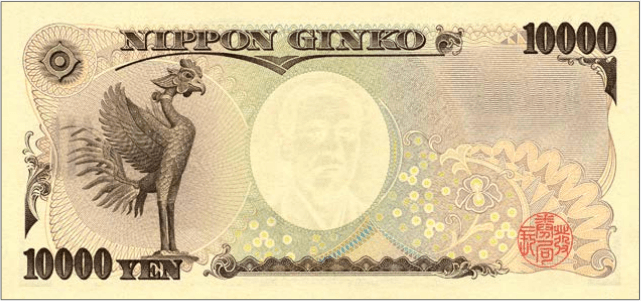
Brown, green and orange. Front: Japanese text; Fukuzawa Yukichi (author and civil rights activist). Back: English text; standing cockerel. No security thread. Watermark: Fukuzawa Yukichi. Printer code: L. 160 x 76 mm. Paper.
2000 Commemorative Issue
This 2,000-yen note commemorates the G8 (Group of Eight) Summit held in Okinawa, Japan on 21-23 July 2000. Manufacturers of vending machines, ubiquitous in Japan, were reluctant to reconfigure them to take this note and it quickly became unpopular with the general public. Production ceased in 2003 and they are now rarely found in circulation. The exception is the islands of Okinawa, due to both the illustrations on the note and the fact that US$20 notes were familiar to the population (Okinawa was an American military possession until 17 June 1972).This note has the text 日本銀行券 (Bank of Japan note) at upper front and Nippon Ginko at upper back. Notes with 1-letter prefixes command a 1.5x premium.
Description: 2,000.00 JPY – Japanese Yen Size: 154 x 76 mm
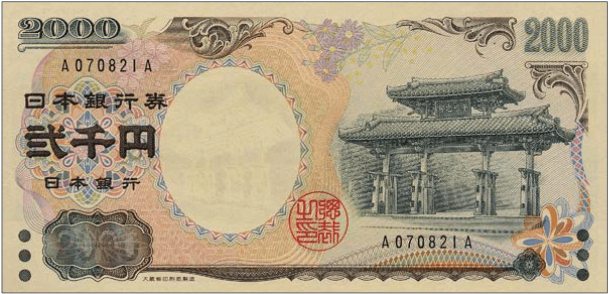
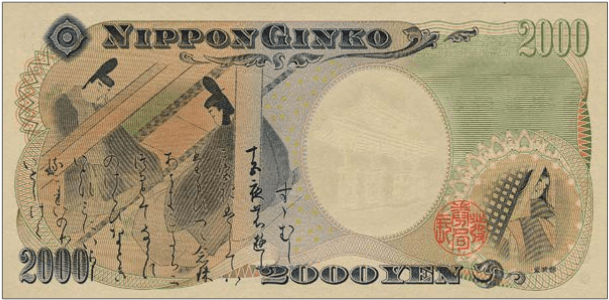
Multicolored. Front: Japanese text; main gate of Shuri Castle in Naha, Okinawa. Back: English and Japanese text; Scrolls and calligraphy depicting events in TheTale of Genji(world’s first novel, early 11th century) and The Diary of Lady Murasaki (c. 1010). No security thread. Watermark: Gate of Shuri Castle. Printer code: I. 154 x 76 mm. Paper.
1984 – 2003 Literature Issues
These notes each feature a portrait of a different Japanese writer and have the text 日本銀行券 (Bank of Japan note) at upper front and Nippon Ginko at upper back. Notes with 1-letter prefixes command a 1.75x premium.
Description: 1,000.00 JPY – Japanese Yen Size: 150 x 76 mm
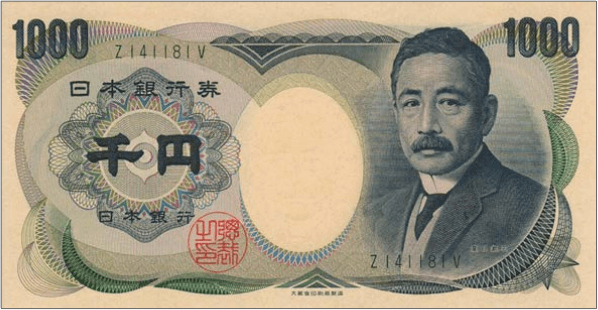
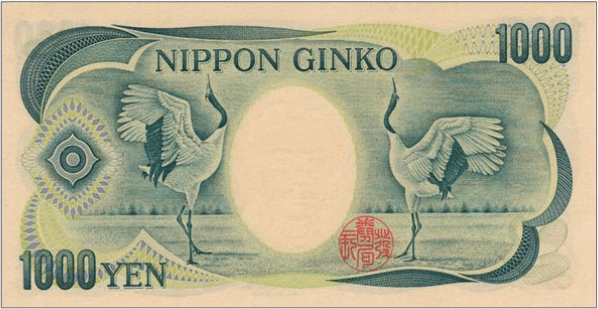
Blue and red. Front: Japanese text; Natsume Sōseki (author). Back: English text; two cranes in mating dance. No security thread. Watermark: Natsume Sōseki. 150 x 76 mm. Paper.
Description: 5,000.00 JPY – Japanese Yen Size: 155 x 76 mm
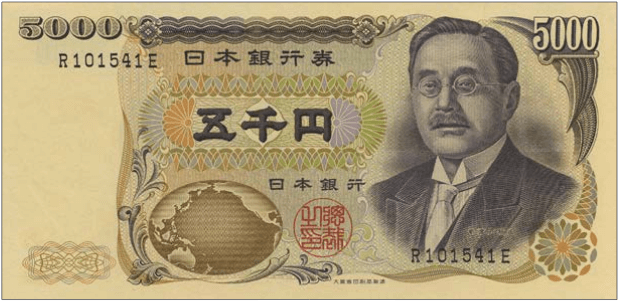
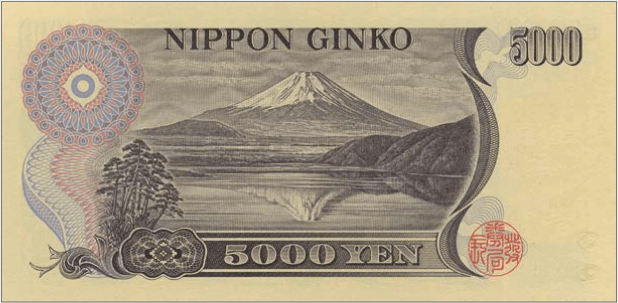
Brown, purple, orange, and red. Front: Japanese text; oval globe of earth; Nitobe Inazō (economist, author, politician). Back: English text; Mount Fuji and foothills. No security thread. Watermark: Nitobe Inazō. 155 x 76 mm. Paper.
Description: 10,000.00 JPY – Japanese Yen Size: 160 x 76 mm


Brown and black. Front: Japanese text; Fukuzawa Yukichi (author and civil rights activist). Back: English text; standing pheasant; lying pheasant. No security thread. Watermark: Fukuzawa Yukichi. 160 x 76 mm. Paper.
Expectations
On 9 April 2019, Japan’s Ministry of Finance announced plans to introduce a new series of notes in the first half of 2024. The new series will consists of three denominations (the existing 2,000-yen note is not being replaced) featuring bacteriologist Kitasato Shibasaburō on the 1,000-yen note; Tsuda Umeko, founder of Tsuda Juku University and the first Japanese woman to study in the US, on the 5,000-yen note; and industrialist Shibusawa Eiichi, on the 10,000-yen note. All three notes will feature 3D holographic elements, elaborate watermarks, and larger denomination numbers to aid the sight-impaired. Existing notes will continue to circulate in parallel for three to four years.
Description: 1,000.00 JPY – Japanese Yen Size: 150 x 76 mm
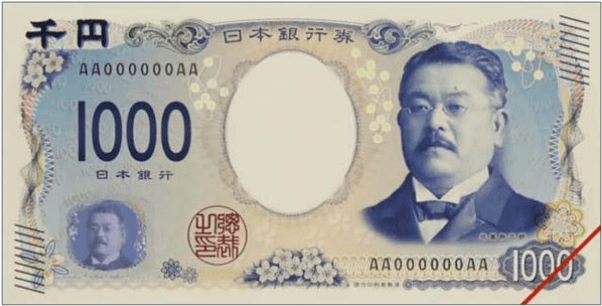

Blue. Front: Japanese text; flowers; Kitasato Shibasaburō (bacteriologist). Back: English text; Katsushika Hosukai’s woodblock print, “The Great Wave of Kanagawa” from “Thirty Six Views of Mount Fuji.” Holographic patch. Unknown security thread. Watermark: Unknown. Printer code: Unknown. 150 x 76 mm. Paper.
Description: 5,000.00 JPY – Japanese Yen Size: 156 x 76 mm
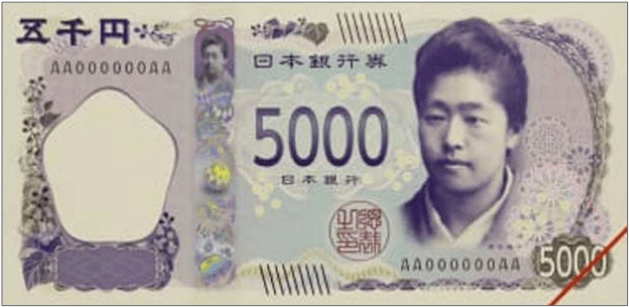
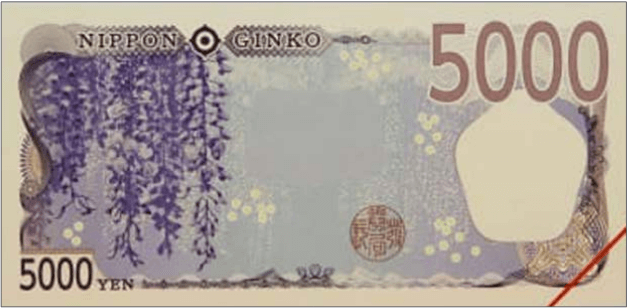
Lilac. Front: Japanese text; flowers; Tsuda Umeko (educator). Back: English text; wisteria flowers. Holographic stripe. Unknown security thread. Watermark: Unknown. Printer code: Unknown. 156 x 76 mm. Paper.
Description: 10,000.00 JPY – Japanese Yen Size: 160 x 76 mm
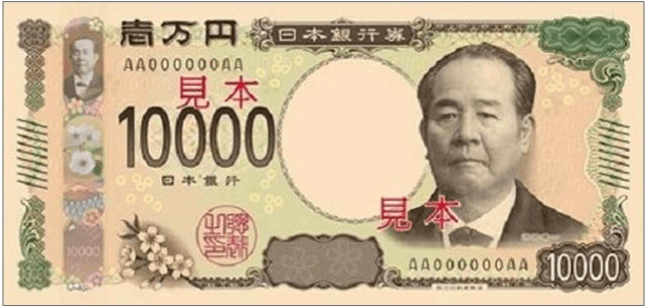
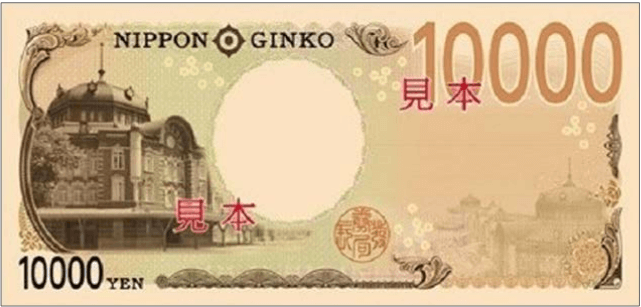
Brown. Front: Japanese text; flowers; Shibusawa Eiichi (industrialist). Back: English text; Marunouchi side of red brick railroad Tokyo Station from 1914. Holographic stripe. Unknown security thread. Watermark: Unknown. Printer code: Unknown. 160 x 76 mm. Paper.
